PORSCHE CAYNNE 2004 1.G Owners Manual
Manufacturer: PORSCHE, Model Year: 2004, Model line: CAYENNE, Model: PORSCHE CAYENNE 2004 1.GPages: 379, PDF Size: 13.91 MB
Page 261 of 379
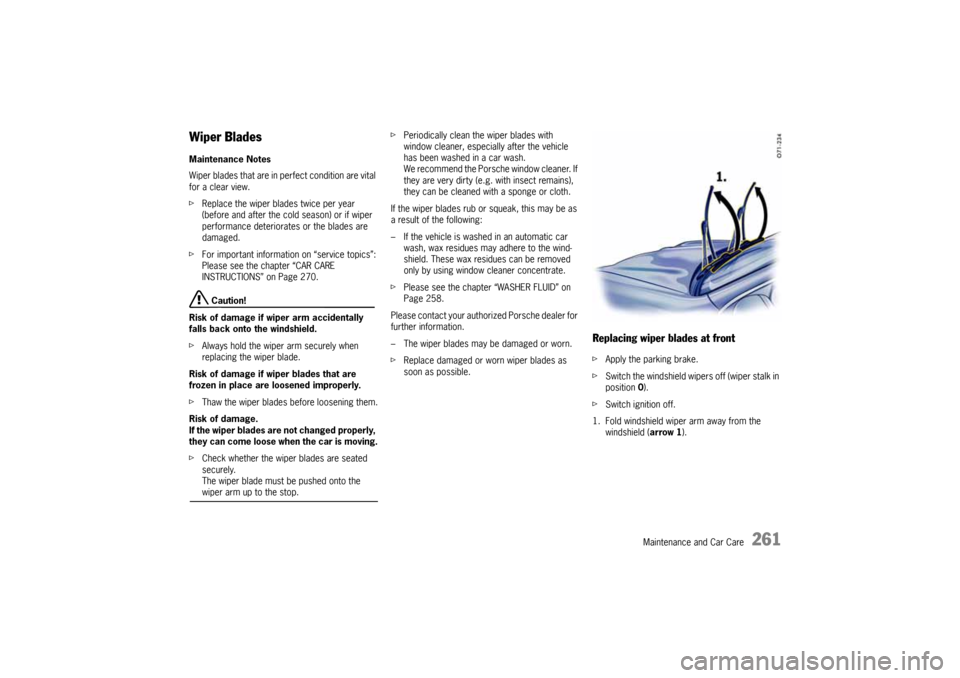
Maintenance and Car Care
261
Wiper BladesMaintenance Notes
Wiper blades that are in perfect condition are vital
for a clear view.
fReplace the wiper blades twice per year
(before and after the cold season) or if wiper
performance deteriorates or the blades are
damaged.
fFor important information on “service topics”:
Please see the chapter “CAR CARE
INSTRUCTIONS” on Page 270.
Caution!
Risk of damage if wiper arm accidentally
falls back onto the windshield.
fAlways hold the wiper arm securely when
replacing the wiper blade.
Risk of damage if wiper blades that are
frozen in place are loosened improperly.
fThaw the wiper blades before loosening them.
Risk of damage.
If the wiper blades are not changed properly,
they can come loose when the car is moving.
fCheck whether the wiper blades are seated
securely.
The wiper blade must be pushed onto the wiper arm up to the stop. fPeriodically clean the wiper blades with
window cleaner, especially after the vehicle
has been washed in a car wash.
We recommend the Porsche window cleaner. If
they are very dirty (e.g. with insect remains),
they can be cleaned with a sponge or cloth.
If the wiper blades rub or squeak, this may be as
a result of the following:
– If the vehicle is washed in an automatic car
wash, wax residues may adhere to the wind-
shield. These wax residues can be removed
only by using window cleaner concentrate.
fPlease see the chapter “WASHER FLUID” on
Page 258.
Please contact your authorized Porsche dealer for
further information.
– The wiper blades may be damaged or worn.
fReplace damaged or worn wiper blades as
soon as possible.
Replacing wiper blades at frontfApply the parking brake.
fSwitch the windshield wipers off (wiper stalk in
position 0).
fSwitch ignition off.
1. Fold windshield wiper arm away from the
windshield (arrow 1).
10_Cayenne_21_KW17.book Seite 261 Donnerstag, 9. April 2009 3:33 15
Page 262 of 379
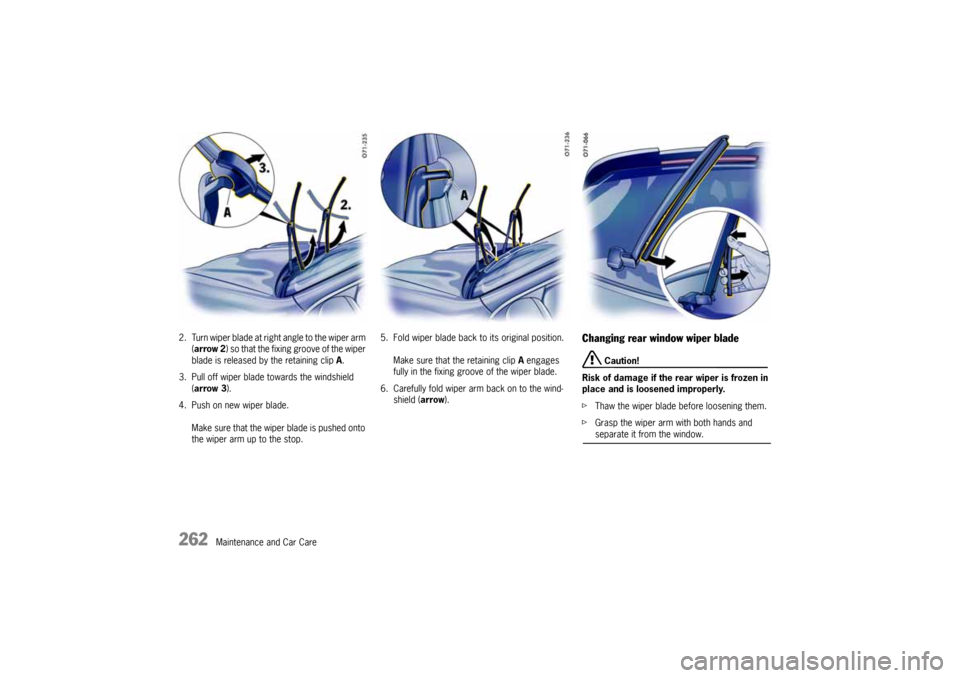
262
Maintenance and Car Care 2. Turn wiper blade at right angle to the wiper arm
(arrow 2) so that the fixing groove of the wiper
blade is released by the retaining clip A.
3. Pull off wiper blade towards the windshield
(arrow 3).
4. Push on new wiper blade.
Make sure that the wiper blade is pushed onto
the wiper arm up to the stop.5. Fold wiper blade back to its original position.
Make sure that the retaining clip A engages
fully in the fixing groove of the wiper blade.
6. Carefully fold wiper arm back on to the wind-
shield (arrow).
Changing rear window wiper blade
Caution!
Risk of damage if the rear wiper is frozen in
place and is loosened improperly.
fThaw the wiper blade before loosening them.
fGrasp the wiper arm with both hands and separate it from the window.
10_Cayenne_21_KW17.book Seite 262 Donnerstag, 9. April 2009 3:33 15
Page 263 of 379

Maintenance and Car Care
263
1. Apply the parking brake.
2. Switch ignition off.
3. Carefully fold the wiper arm away from the rear
window until it reaches its locking position
(approx. 60°).
4. Carefully unclip the wiper blade from the wiper
arm (arrow). Hold the wiper arm with your
other hand when doing this.
5. Push the new wiper blade onto the wiper arm
and snap it into place.
6. Carefully fold wiper arm back on to the rear
window.
Emission Control SystemIn the interest of clean airPollution of our environment has become a
problem that is of increasing concern to all of us.
We urge you to join us in our efforts for cleaner air
in controlling the pollutants emitted from the auto-
mobile.
Porsche has developed an emission control
system that controls or reduces those parts of the
emission that can be harmful to our environment.
Your Porsche is equipped with such a system.
Porsche warrants the Emission Control System in
your new car under the terms and conditions set
forth in the Warranty Booklet.
You, as the owner of the vehicle, have the respon-
sibility to provide regular maintenance service for
the vehicle and to keep a record of all mainte-
nance work performed. To facilitate record
keeping, have the service performed by
authorized Porsche dealers. They have Porsche
trained technicians and special tools to provide
fast and efficient service.To assure efficient operation of the Emission
Control System:
fHave your vehicle maintained properly and in
accordance with the recommendations
described in your Maintenance Booklet. Lack
of proper maintenance, as well as improper
use of the vehicle, will impair the function of
the emission control system and could lead to
damage.
fDo not alter or remove any component of the
emission control system.
fDo not alter or remove any device, such as
heat shields, switches, ignition wires, valves,
etc., which are designed to protect your
vehicle's emission control system. In addition
to serious engine damage, this can result in a
fire if excess raw fuel reaches the exhaust
system.
fDo not continue to operate your vehicle if you
detect engine misfire or other unusual opera-
ting conditions.
10_Cayenne_21_KW17.book Seite 263 Donnerstag, 9. April 2009 3:33 15
Page 264 of 379
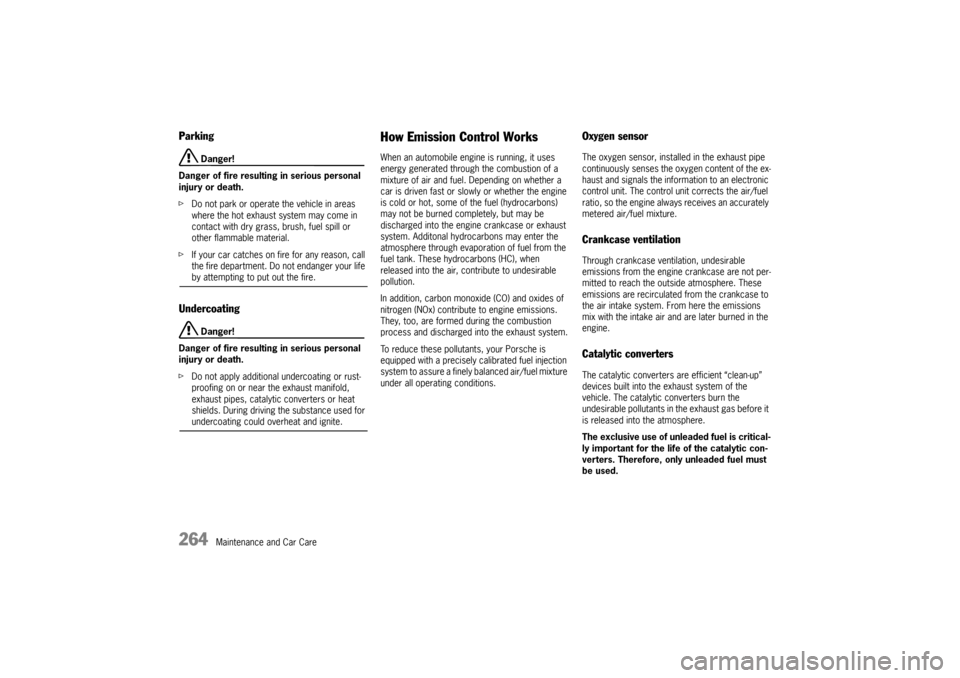
264
Maintenance and Car Care
Parking
Danger!
Danger of fire resulting in serious personal
injury or death.
fDo not park or operate the vehicle in areas
where the hot exhaust system may come in
contact with dry grass, brush, fuel spill or
other flammable material.
fIf your car catches on fire for any reason, call
the fire department. Do not endanger your life by attempting to put out the fire.
Undercoating
Danger!
Danger of fire resulting in serious personal
injury or death.
fDo not apply additional undercoating or rust-
proofing on or near the exhaust manifold,
exhaust pipes, catalytic converters or heat
shields. During driving the substance used for undercoating could overheat and ignite.
How Emission Control WorksWhen an automobile engine is running, it uses
energy generated through the combustion of a
mixture of air and fuel. Depending on whether a
car is driven fast or slowly or whether the engine
is cold or hot, some of the fuel (hydrocarbons)
may not be burned completely, but may be
discharged into the engine crankcase or exhaust
system. Additonal hydrocarbons may enter the
atmosphere through evaporation of fuel from the
fuel tank. These hydrocarbons (HC), when
released into the air, contribute to undesirable
pollution.
In addition, carbon monoxide (CO) and oxides of
nitrogen (NOx) contribute to engine emissions.
They, too, are formed during the combustion
process and discharged into the exhaust system.
To reduce these pollutants, your Porsche is
equipped with a precisely calibrated fuel injection
system to assure a finely balanced air/fuel mixture
under all operating conditions.
Oxygen sensorThe oxygen sensor, installed in the exhaust pipe
continuously senses the oxygen content of the ex-
haust and signals the information to an electronic
control unit. The control unit corrects the air/fuel
ratio, so the engine always receives an accurately
metered air/fuel mixture.Crankcase ventilationThrough crankcase ventilation, undesirable
emissions from the engine crankcase are not per-
mitted to reach the outside atmosphere. These
emissions are recirculated from the crankcase to
the air intake system. From here the emissions
mix with the intake air and are later burned in the
engine.Catalytic convertersThe catalytic converters are efficient “clean-up”
devices built into the exhaust system of the
vehicle. The catalytic converters burn the
undesirable pollutants in the exhaust gas before it
is released into the atmosphere.
The exclusive use of unleaded fuel is critical-
ly important for the life of the catalytic con-
verters. Therefore, only unleaded fuel must
be used.
10_Cayenne_21_KW17.book Seite 264 Donnerstag, 9. April 2009 3:33 15
Page 265 of 379

Maintenance and Car Care
265
The catalytic converters will be damaged by:
– push or tow starting the vehicle
– misfiring of the engine
– turning off the ignition while the vehicle is
moving or
– driving until the fuel tank is completely empty
– by other unusual operating conditions.
fDo not continue to operate your vehicle under
these conditions, since raw fuel might reach
the catalytic converters. This could result in
overheating of the converters. Federal law
prohibits use of leaded fuel in this car.
Fuel EconomyFuel economy will vary depending on where,
when and how you drive, optional equipment
installed, and the general condition of your
car.
A car tuned to specifications and correctly
maintained, will help you to achieve optimal
fuel economy.
fHave your vehicle tuned to specifications. Air
cleaner should be dirt free to allow proper
engine “breathing”.
Battery should be fully charged.
Wheels should be properly aligned.
Tires should be inflated to the correct
pressure.
fAlways monitor your fuel consumption.
fDrive smoothly, avoid abrupt changes in speed
as much as possible.
fAvoid jack rabbit starts and sudden stops.
fDo not drive longer than necessary in the lower
gears. Shifting into a higher gear early without
lugging the engine will help save fuel.
fProlonged “warm up” idling wastes gas. Start
the vehicle just before you are ready to drive.
Accelerate slowly and smoothly.fSwitch off the engine if stationary for longer
periods.
fAny additional weight carried in the vehicle
re d u c e s f u e l e c o n o m y. A l w a ys k e e p c a rg o t o a
minimum and remove all unnecessary items.
fOrganize your trips to take in several errands
in one trip.
fAll electrical accessories contribute to
increased fuel consumption.
fOnly switch on the air conditioning when neces-
sary.
fDo not drive with the Roof Transport System
mounted unless you need it.
The EPA estimated miles per gallon (mpg) is
to be used for comparison purposes, actual
mileage may be different from the estimated
mpg, depending on your driving speed,
weather conditions and trip length. Your
actual highway mileage will probably be less
than the estimated mpg.
fPlease see all local and national speed limits.
10_Cayenne_21_KW17.book Seite 265 Donnerstag, 9. April 2009 3:33 15
Page 266 of 379

266
Maintenance and Car Care
Operating Your Porsche in other
CountriesGovernment regulations in the United States and
Canada require that automobiles meet specific
emission regulations and safety standards. There-
fore, cars built for the U.S. and Canada differ from
vehicles sold in other countries.
If you plan to take your Porsche outside the conti-
nental limits of the United States or Canada, there
is the possibility that
– unleaded fuel may not be available;
– unleaded fuel may have a considerably lower
octane rating. Excessive engine knock and
serious damage to both engine and catalytic
converters could result;
– service may be inadequate due to lack of
proper service facilities, tools or diagnostic
equipment;
– replacement parts may not be available or very
difficult to get.
Porsche cannot be responsible for the me-
chanical damage that could result because
of inadequate fuel, service or parts availabi-
lity.
If you purchased your Porsche abroad and want to
bring it back home, be sure to find out about ship-
ping and forwarding requirements, as well as
current import and customs regulations.
Fuel
Warning!
Fuel is highly flammable and harmful to
health.
fFire, open flame and smoking are prohibited
when handling fuel.
fAvoid contact with skin or clothing.
fDo not inhale fuel vapours.
To prevent damage to the emission control
system and engine:
fNever drive the tank completely out of fuel.
fAvoid high cornering speeds after the warning lights have come on.
To avoid permanent damage to the functionality of
the catalytic converters and oxygen sensors, use
only unleaded fuel.
The engine is designed to provide optimum
performance and fuel consumption if unleaded
premium fuel with 98 RON/88 MON is used.
If unleaded premium fuels with octane numbers of
at least 95 RON/85 MON are used, the
engine's knock control automatically adapts the
ignition timing.The emission control system can be damaged in
various ways (e.g. fueling incorrectly, shortage of
fuel, tow-starting).
fPlease see the chapter “HOW EMISSION
CONTROL WORKS” on Page 264.
fPlease see the chapter “DISPLAYING STATUS
OF LEVEL CONTROL” on Page 131.
10_Cayenne_21_KW17.book Seite 266 Donnerstag, 9. April 2009 3:33 15
Page 267 of 379
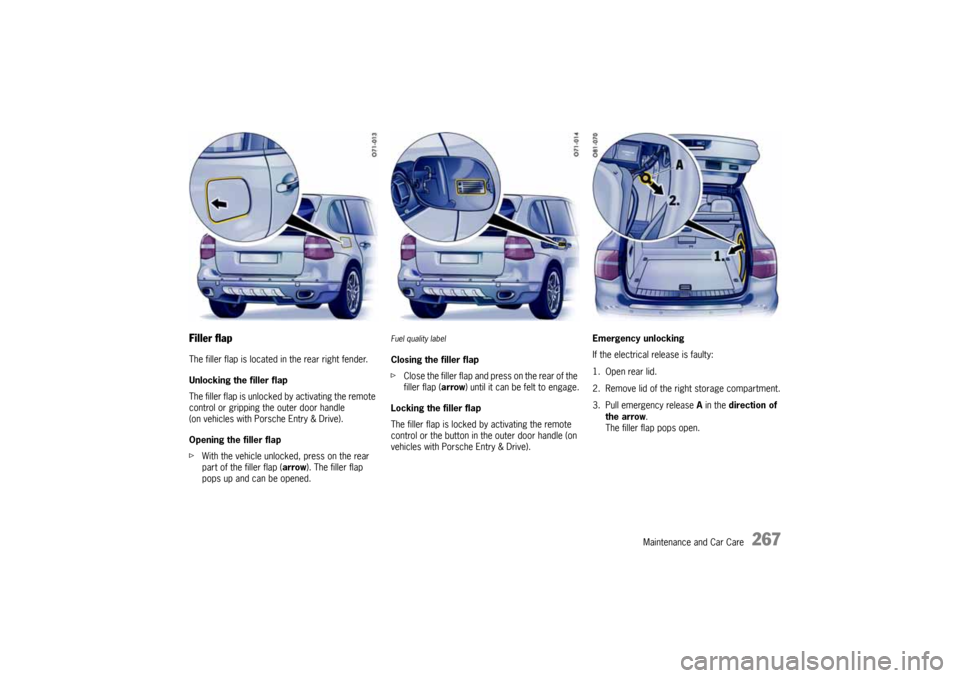
Maintenance and Car Care
267
Filler flapThe filler flap is located in the rear right fender.
Unlocking the filler flap
The filler flap is unlocked by activating the remote
control or gripping the outer door handle
(on vehicles with Porsche Entry & Drive).
Opening the filler flap
fWith the vehicle unlocked, press on the rear
part of the filler flap (arrow). The filler flap
pops up and can be opened.
Fuel quality labelClosing the filler flap
fClose the filler flap and press on the rear of the
filler flap (arrow) until it can be felt to engage.
Locking the filler flap
The filler flap is locked by activating the remote
control or the button in the outer door handle (on
vehicles with Porsche Entry & Drive).Emergency unlocking
If the electrical release is faulty:
1. Open rear lid.
2. Remove lid of the right storage compartment.
3. Pull emergency release A in the direction of
the arrow.
The filler flap pops open.
10_Cayenne_21_KW17.book Seite 267 Donnerstag, 9. April 2009 3:33 15
Page 268 of 379
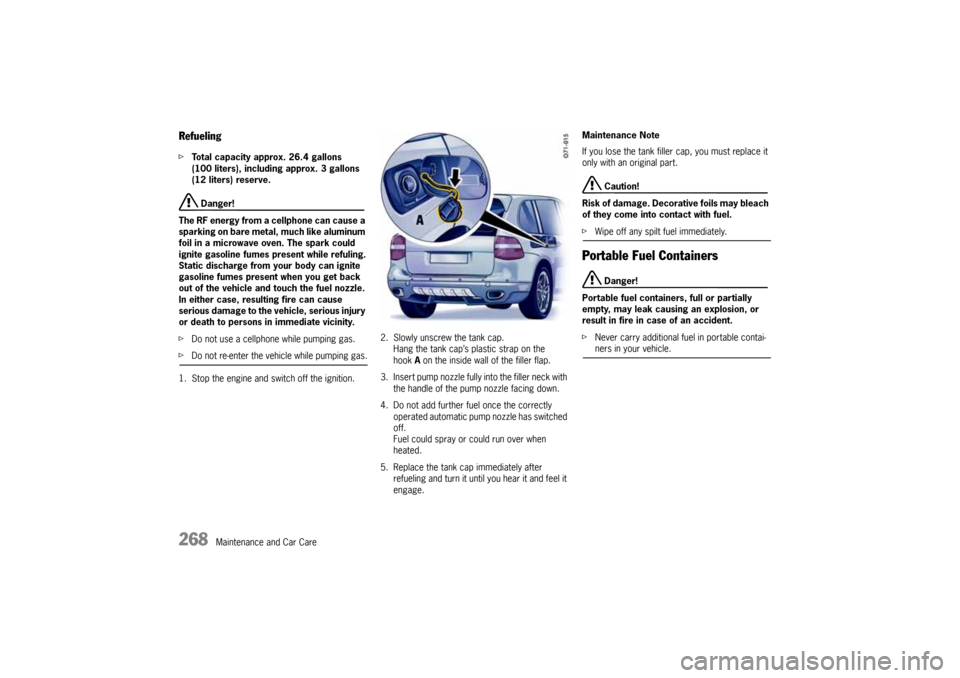
268
Maintenance and Car Care
RefuelingfTotal capacity approx. 26.4 gallons
(100 liters), including approx. 3 gallons
(12 liters) reserve.
Danger!
The RF energy from a cellphone can cause a
sparking on bare metal, much like aluminum
foil in a microwave oven. The spark could
ignite gasoline fumes present while refuling.
Static discharge from your body can ignite
gasoline fumes present when you get back
out of the vehicle and touch the fuel nozzle.
In either case, resulting fire can cause
serious damage to the vehicle, serious injury
or death to persons in immediate vicinity.
fDo not use a cellphone while pumping gas.
fDo not re-enter the vehicle while pumping gas.
1. Stop the engine and switch off the ignition.2. Slowly unscrew the tank cap.
Hang the tank cap’s plastic strap on the
hookA on the inside wall of the filler flap.
3. Insert pump nozzle fully into the filler neck with
the handle of the pump nozzle facing down.
4. Do not add further fuel once the correctly
operated automatic pump nozzle has switched
off.
Fuel could spray or could run over when
heated.
5. Replace the tank cap immediately after
refueling and turn it until you hear it and feel it
engage.Maintenance Note
If you lose the tank filler cap, you must replace it
only with an original part.
Caution!
Risk of damage. Decorative foils may bleach
of they come into contact with fuel.
fWipe off any spilt fuel immediately.Portable Fuel Containers
Danger!
Portable fuel containers, full or partially
empty, may leak causing an explosion, or
result in fire in case of an accident.
fNever carry additional fuel in portable contai-ners in your vehicle.
10_Cayenne_21_KW17.book Seite 268 Donnerstag, 9. April 2009 3:33 15
Page 269 of 379

Maintenance and Car Care
269
Fuel RecommendationsYour Porsche is equipped with catalytic conver-
ters and must use UNLEADED FUEL ONLY.
Your engine is designed to provide optimum
performance and fuel economy using unleaded
premium fuel with an octane rating of 98 RON
(93 CLC or AKI). Porsche therefore recom-
mends the use of these fuels in your vehicle.
Porsche also recognizes that these fuels may not
always be available. Be assured that your vehicle
will operate properly on unleaded premium fuels
with octane numbers of at least 95 RON
(90 CLC or AKI), since the engine's “Electronic
Octane™ knock control” will adapt the ignition
timing, if necessary.
It is important to observe the regular service inter-
vals, and particularly the oil change intervals, spe-
cified in your Maintenance Schedule.
The use of UNLEADED FUEL ONLY is critically
important to the life of the catalytic
converters. Deposits from leaded fuels will
ruin the converters and make it ineffective
as an emission control device.
Cars with catalytic converters have a smaller fuel
tank opening, and gas station pumps have smaller
nozzles. This will prevent accidental pumping of
leaded fuel into cars with catalytic converters.Unleaded fuels may not be available outside the
continental U.S. and Canada. Therefore, we
recommend you do not take your car to areas or
countries where unleaded fuel may not be
available.
Octane ratingsOctane rating indicates a fuel's ability to resist
detonation. Therefore, buying the correct octane
gas is important to prevent engine “damage”.
The RON octane rating is based on the research
method. The CLC (U.S. Cost of Living Council oc-
tane rating) or AKI (antiknock index) octane rating
usually displayed on U.S. fuel pumps is calculated
as research octane number plus motor octane
number, divided by 2, that is written as:
The CLC or AKI octane rating is usually lower than
the RON rating:
For example: 95 RON corresponds 90 CLC or
“AKI”
fDo not use fuel additives without Porsche
approval.
Fuels containing ethanolfDo not use any fuels containing more than 10
percent ethanol by volume.
We recommend, however, to change to a different
fuel or station if any of the following problems
occur with your vehicle:
– Deterioration of driveability and performance.
– Substantially reduced fuel economy.
– Vapor lock and non-start problems, especially
at high altitude or at high temperature.
– Engine malfunction or stalling.
RON MON+
2 ----------------------------------
orRM+
2 ---------------
10_Cayenne_21_KW17.book Seite 269 Donnerstag, 9. April 2009 3:33 15
Page 270 of 379

270
Maintenance and Car Care
Fuel Evaporation ControlFuel tank ventingThe evaporation chamber and the carbon canister
prevent fuel from escaping to the atmosphere at
extreme high outside temperatures, when driving
abruptly around curves and when the car is parked
at an incline or in any other nonlevel position.Vapor control system and storageWhen the fuel tank is filled, vapors are collected in
the evaporation chamber by a vent line leading the
vapors to the carbon canister where they are
stored as long as the engine does not run.Purge systemWhen the engine is running, the fuel vapors from
the canister will be mixed with fresh air from the
ambient air of the canister. This mixture will be
directed to the intake air housing by the tank vent
line, mixed with the intake air and burned during
normal combustion.
Car Care InstructionsfPlease see the chapter “EXERCISE EXTREME
CAUTION WHEN WORKING ON YOUR VEHICLE”
on Page 250.
Regular and correct care helps to maintain
the value of your car and is also a
precondition for the New Vehicle Warranty
and the Anti Corrosion Warranty.
Your authorized Porsche dealer has specially
developed car-care products from the
Porsche program available either singly or
as complete car-care sets. They will be
pleased to help you select suitable products.
Whether you use Porsche products or other
commercially available cleaning agents first
make sure of their correct application.
A Porsche that is well-cared for can look like new
for years. It all depends on the amount of care the
owner is willing to give the car.
Warning!
Risk of serious personal injury or damage to
the vehicle or property.
Cleaning agents may be hazardous to your
health.
Most chemical cleaners are concentrates
which require dilution. High concentrations
might cause problems ranging from irritation
to serious injury as well as damage to your
vehicle.
fKeep cleaning agents out of reach from
children.
fObserve all caution labels.
fAlways read directions on the container before
using any product. These directions may con-
tain information necessary to avoid personal
injury.
fDo not use fuel, kerosene, naphtha, nail polish
remover or other volatile cleaning fluids. They
may be toxic, flammable or hazardous in other
ways. Only use spot removing fluids in a well
vented area.
fDo not clean the underside of chassis,
fenders, wheel covers, etc., without protecting
your hands and arms as you may cut yourself on sharp-edged metal parts.
Moisture and road salt on brakes may affect
braking efficiency.
Test the brakes after each vehicle washing.
10_Cayenne_21_KW17.book Seite 270 Donnerstag, 9. April 2009 3:33 15